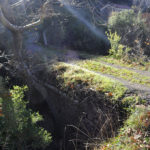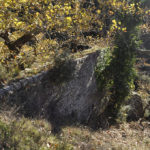Project Description
Trail 2 | Neda – Neda Springs – Abeliona
| 5,4 Km | 1h 55′ | 1/5 |
Starting Point: : Neda (spring)
Ending Point: Abeliona
Main Sights: Neda Springs, Petra
Connected To: Trail 1 | Neda – Abeliona – Epicurius Apollon, Trail 3 | Abeliona – Agios Sostis – Neda
The trail starts from the village of Neda, previously called Berekla. Through a beautiful dust road, the trail starts descending passing by the old church watermill, a stone-built bridge and the churches of Panagitsa and Agios Georgios. A bit further away, on the other side of the stream, you will find the famous Neda Springs, where the water pours out from the earth. Next to the springs there is the church of Agianastasi. Be careful to not try to cross the river when there is water flowing down. Going up the hill from there, the old path reaches the village of Petra, previously called Delga. You can either cross the traditional village or bypass it and head straight downhill to the village of Abeliona. After a few meters on dust and asphalt roads next to planted walnut trees, the trail turns again into a narrower path. At the beginning of the way uphill there is the water fountain of Variko, an ideal spot to stop for a few minutes under the shade of the plane trees. The path continues then uphill, till it meets broader dust roads offering great views to the surrounding mountains of Lykaion and Tetrazi. The old footpath continues downhill till the fountain of Tritseli, where you meet the APOLLO TRAIL 1 (Neda – Abeliona – Apollo Epicurius). From there, the short way uphill finishes at the village of Abeliona, an ideal spot for lunch and rest.
Seightseeing Spots
Neda Springs
The river of Neda is considered to be stemming from this point, as the water from all rivers and streams end up here. During summer, when the water level is lower, the water bubbles up from the bottom of a small lake. During winter, however, they are bursting out foaming impressively and loudly through a crack in the rock. The springs’ small lake was feeding the watermill of Karamichas, which is well preserved 100 meters along the way, next to the river. Next to the springs you will see the picturesque little church of Agianastasi, functioning twice per year, at the Epiphany, when they are throwing a cross in the springs’ lake, and the Assumption of Mary. The local associations organize every summer two-day river trekking of Neda River, starting from that point. It is an excursion of great interest, yet very difficult and dangerous. Do not try that on your own.
The stone bridge
It bridges the two banks if a side-river of Neda that has its springs at the spot of Rasaina, and flows towards the village of Neda, a little bit before its springs. The bridge is stone-built and with one arch, exactly like the one you meet when you walk along Trail 1. It is unknown when it was built but it is proof of the capacity of the region’s builders. Indeed, till fairly recently, perfect craftsmen with expertise in stone lived and worked in the region’s villages. Their work is still to see in houses, bridges and churches. However, famous groups of craftsmen from the village of Lagadia in the nearby region of Gortynia were also visiting the region to contribute with the building.
The church’s watermill
We run across the watermill in the first part of the trail, before we meet the arched bridge and the little churches of Panagitsa and Agios Georgios near the village of Berekla. Unfortunately, nowadays, you can only see the ruins. However, in older times, it was the main alternative for villagers from Abeliona and Petra, when there was a long queue at the mill of Karamichas. It was working with the power of water stemming from Rasaina, mainly during the winter months, as in the summer the water was becoming fewer. At a lower level, close to the village of Kakaletri, the water of the Neda River could still make a lot of watermills function.








